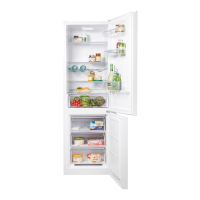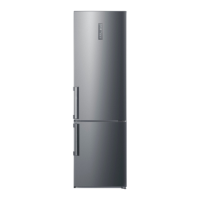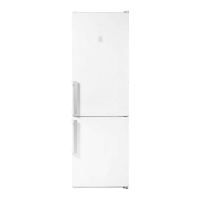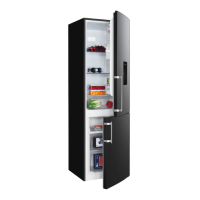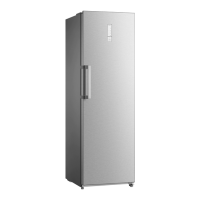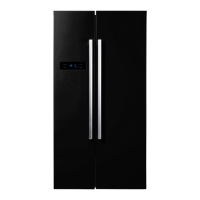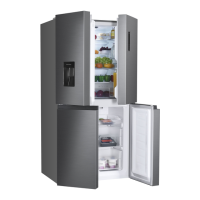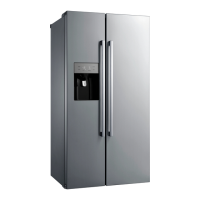Cleaning the inner
compartment
The fridge and freezer compartment does not
need to be defrosted as it is equipped with
an automated thawing function. Frost and ice
are automatically defrosted and the thaw wa-
ter is collected in a thaw water container on
the reverse side of the appliance. The thaw
water evaporates as a result of the heat gen-
erated by the compressor.
Before cleaning the freezer compart-
ment, first create accumulated refrigera-
tion. To do this, set the temperature in the
freezer compartment mode to –24 °C for
at least 1 hour prior to cleaning.
The deep frozen food will now not defrost as
quickly.
CAUTION
Danger of explosion!
Improper handling of the appliance
can lead to defl agration or explosion!
■ Never use defrosting sprays. They can
generate explosive gases.
■ Do not use any means other than
those recommended by the manufac-
turer to speed up defrosting. For ex-
ample, do not use any electric heat-
ing equipment, knives or devices with
an open fl ame such as a candle. The
thermal insulation and the interior
walls are scratch- and heat-sensitive
and can melt.
1. Pull the mains plug out of the socket.
2. Remove the frozen food from the freezer.
3. Ensure that your food is kept cool
enough. If you haven’t got the opportu-
nity to store the frozen food in another
freezer in the meantime, wrap it up in a
thick layer of newspaper and store it in
a cool room or in an insulated bag while
cleaning.
4. Remove the freezer drawers (6) from
the freezer compartment. Wash them in
warm water with washing up liquid and
dry thoroughly.
5. Remove the vegetable drawer (9), the
cold-storage compartment (7) and the
glass shelves (11) from the fridge com-
partment.
To remove the door shelves (2), (3) and
(4), push them together slightly to the
sides and simultaneously pull them up-
wards out of the holders.
6. Clean all of the parts in lukewarm soapy
water. Then dry everything thoroughly.
7. Wash the interior with warm water and
washing up liquid.
When wiping clean, add a few drops of
vinegar to the water to prevent mould
formation.
Wipe the interior dry and leave the door
open for a while to air.
8. Only clean the door seals with clean wa-
ter; they are sensitive to oil and fat.
9. Replace the glass shelves, the vege-
table drawer, the freezer drawers, the
cold-storage compartment and the door
shelves.
10. Return the food to the fridge or freezer
compartment.
11. Plug the mains plug back into the socket
and set the temperature (see „Setting
the temperature“ on page EN-12).
Care and maintenancePage EN-20
